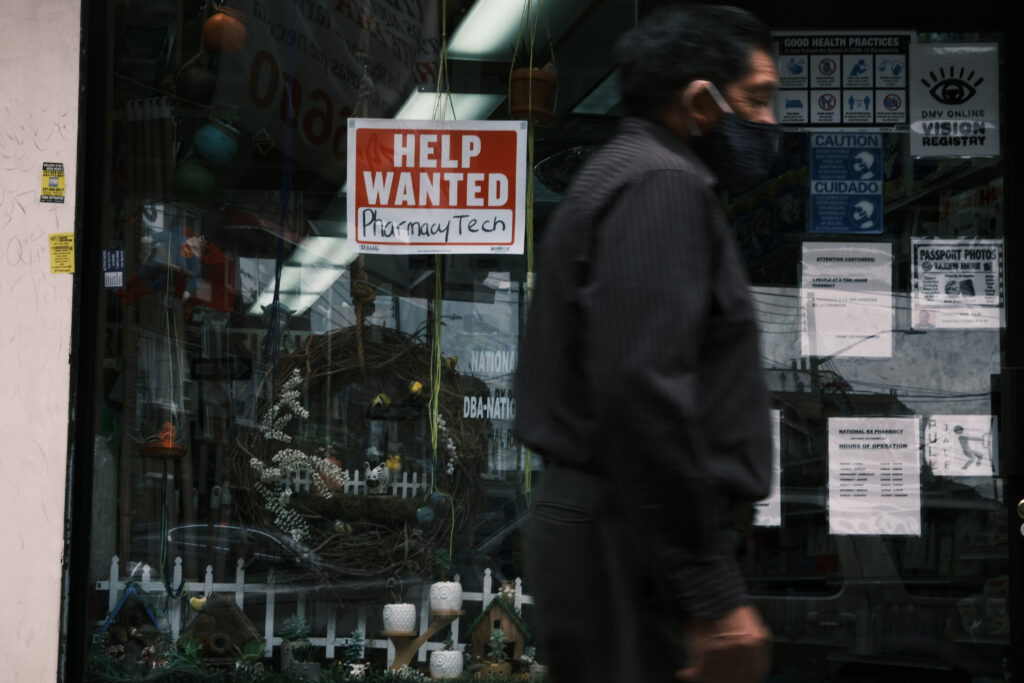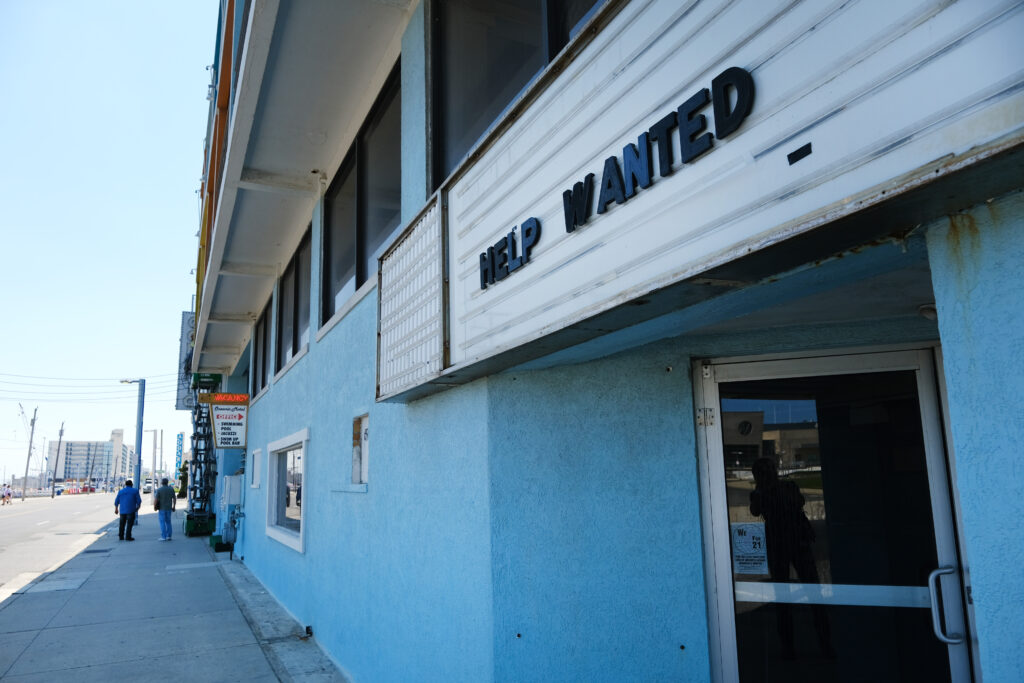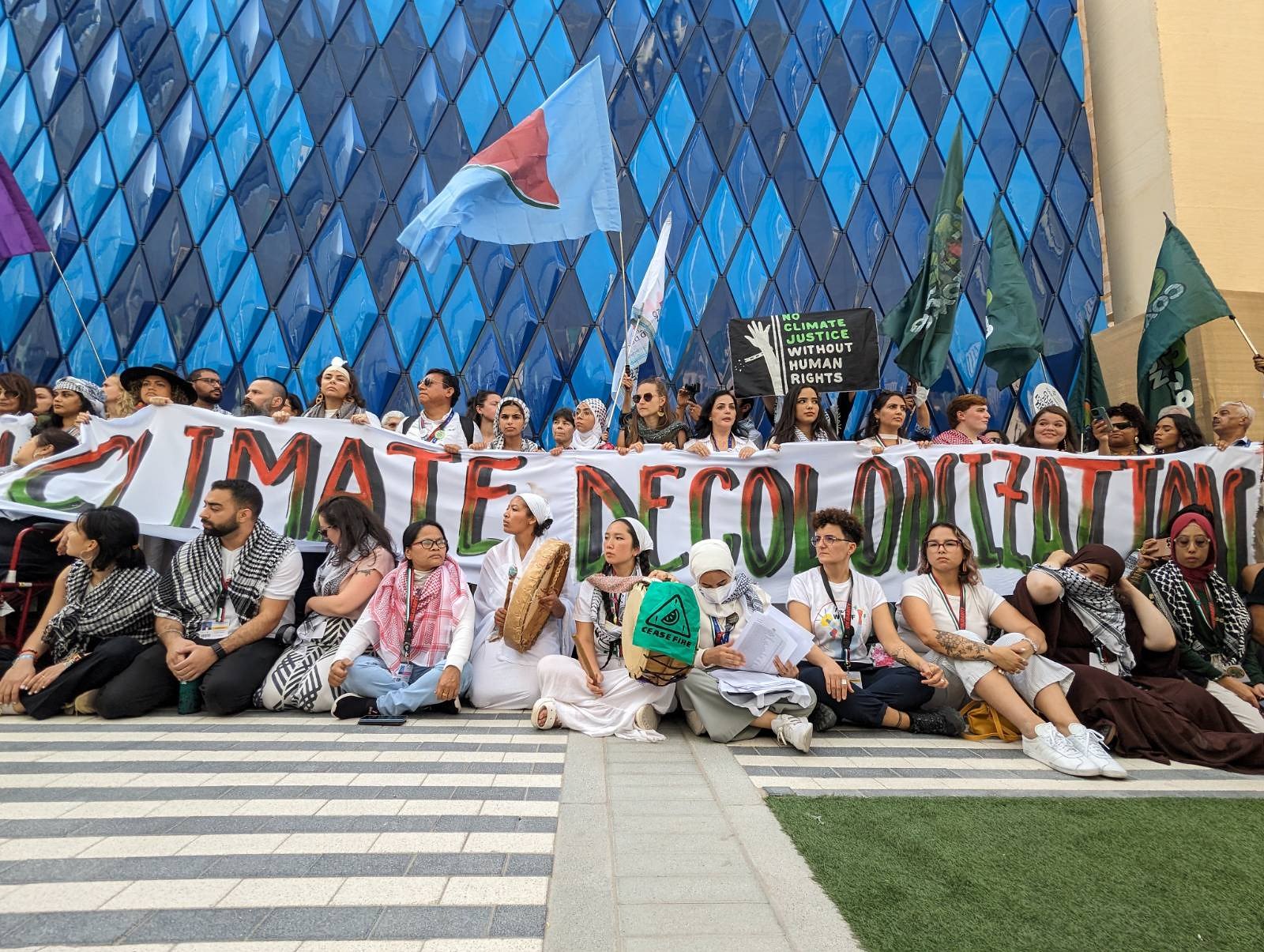As vaccination rates rise and the economy rolls toward “recovery,” news headlines have crackled with reports of employers complaining about an unusual obstacle to resuming their normal operations: not enough workers. After the lockdowns and layoffs of the past year have depleted their staffs, restaurant owners have claimed they are struggling to recruit or rehire servers and cooks. In sectors that usually have high turnover, like retail and food services, frustrated bosses are reportedly trying to lure workers with generous wage hikes or one-time “signing bonuses.” The anecdotes about employers struggling to rehire have snowballed into a narrative of a “labor shortage,” which conveniently plays into the politics of the pandemic recovery. To conservatives, workers are staying home because they’ve grown too comfortable living off government relief.
The Wall Street Journal editorial board claimed in early June that a “mismatch between labor supply and demand” was a result of over-generous aid for the jobless under the American Rescue Plan. The relief package passed earlier this year includes $300 per month in extra unemployment insurance (UI) payments, along with special unemployment assistance for workers traditionally excluded from UI, including many self-employed “gig workers,” and other benefits for the long-term unemployed. The benefits (which disproportionately support workers of color) are set to expire by Labor Day, September 6. But so far 26 Republican-led states have announced that they will cut off UI payments several weeks early, supposedly to discourage workers from idling at home.
With job growth in May coming in slightly under projections and earnings ticking up 9% nationwide over the past year, some on the right have insisted that the government is now “competing” with employers by offering workers free money to stay home.

“Employers have lowered hiring standards and offered signing bonuses. Some are even paying applicants merely to show up for interviews,” the editorial board lamented. It also cited a Chamber of Commerce survey in which the vast majority of businesses self-reported that “a lack of available workers was slowing the economy in their area.”
But what looks like a labor shortage to right-wing pundits may be seen as a small victory for the left. While conservatives blame liberals for “disincentivizing” work, the narrative of a labor shortage serves left-wing observers as well. It appears that that after more than a year of economic turmoil and job losses, some workers are finding that employers are competing to recruit them with better compensation and job quality, and prospective employees have a slightly more capacity to hold out for better jobs. The labor market’s improved offerings might seem to conservatives like an undeserved reward for the jobless, but they actually reflect a small advantage for labor.
Demand and Supply
It’s true that in some pockets of the economy, particularly the leisure and hospitality sectors, there has been greater demand than supply of labor—maybe a fairground that is reopening for the first time in over a year will face difficulty recruiting staff for the summer season, for example, or restaurants that are all reopening at once will end up competing for a relatively small pool of local servers and cooks.
But, to the extent that some communities may see a short-term labor market crunch, left-leaning economists argue that the main problem is not a structural scarcity of labor, but simply a lack of competitive wages and quality jobs. In the rush to reopen the economy, employers—that have for years profited from a chronic age deficit—now face a reckoning.
An Economic Policy Institute (EPI) study observed that in the leisure and hospitality sector, there has been a bump in previously depressed wages that reflects “exactly what is supposed to happen when there is a sectoral imbalance between supply and demand.”
According to weekly earnings data, frontline leisure and hospitality workers earn the equivalent of just over $20,000 annually. The median wage for fast food and restaurant counter workers is just $11.47per hour. Food service jobs are notoriously precarious and often lack benefits like health insurance. The pandemic hit these workers hard, both those who were laid off and those who continued to work through the lockdowns. If these workers are now being offered a little more to return to work, it would hardly offset the massive hardships the workforce endured during the pandemic, including being laid off (if their workplace shut down) or being pressured to work through the lockdown (often without adequate health protections).
According to Mike Konczal, director of Macroeconomic Analysis and Progressive Thought at the Roosevelt Institute, the definition of “labor shortage” in pandemic politics is squishy. Conservatives are using hyperbolic terms to describe temporary labor market imbalances that will eventually be smoothed out as the recovery continues. But there is a kind of labor shortage, he says, in the sense that workers are capable of demanding more from prospective employers, and then wield their leverage “to secure better wages when they take those jobs…But that’s good, we want workers to be able to get better wages. And for a variety of reasons, including the Great Recession, the lagging minimum wage and many other reasons, they haven’t been able to secure that for a long time.”
Still, Konzcal notes that job growth in the restaurant industry has been hitting projections and actually ticked up from March to April—suggesting a divide between the dramatic anecdotes reported in the news about distressed restaurant owners and the macroeconomic reality of an uneven recovery. Besides, it’s difficult to extrapolate long-term trends in the labor market based on just a few months of data.
Moreover, EPI’s analysis shows that many people were indeed returning to the workforce last April, but the net job growth numbers were somewhat offset by an increase in the rate of people leaving employment—those who lose their jobs or drop out of the workforce altogether. Notably, the workers exiting the workforce was led by women—a trend that is “consistent with caregiving responsibilities” that are disproportionately shouldered by women. And the short-term sectoral labor shortages that do exist, EPI argues, are only a problem if they “overheat” the labor market and force employers to boost wages to unsustainably high levels. But leisure and hospitality jobs account for a tiny fraction of total U.S. labor costs, so wage increases in these sectors are unlikely to destabilize others, especially since wages are rising from such a devastatingly low level.
Why not work?
The poor are going back to work at a slower rate than their affluent peers. According to the Opportunity Insights economic tracker, since last April, when millions were pushed out of the workforce, low-wage employment is still down 24% compared to pre-pandemic levels, while employment for high-wage workers actually grew 2.4% over the same period. That trend is an extension of longstanding structural inequalities, which public assistance is remedying only partially.
So for the low-wage workers who have not resumed work just yet, what’s holding them back, if not unemployment benefits?
There are many reasons that job growth is somewhat lagging that have little to do with workers’ individual decisions. For example, businesses that still haven’t seen their normal footfall return might not be in a rush to hire many new workers.
“Not all states and cities are fully reopened,” Konzcal said, “and as they reopen, they’re taking some time to stay open later and customers are taking more time to get reacclimated to going to movies or the mall and restaurants…It’s really more of a demand shortage, that there’s just not enough customers to get people in stores to be even hiring labor.”

The Roosevelt Institute’s analysis of employment data in the first several months of the recovery also undercuts the “unemployment benefits make workers lazy” theory because it indicates that “missing jobs”—where hiring seems to be lagging—are concentrated in a middling income range, $18.50 to $31.50 an hour, which exceeds the maximum level of income that would be covered by unemployment insurance.
In addition, many frontline low-wage workers remain, quite reasonably, reluctant to return to a workplace where they may be exposed to a deadly disease, especially now that basic safeguards like mask mandates are being lifted. According to surveys conducted by the Census Bureau, despite increases in vaccination rates overall, as of mid-June the vaccination rate among those earning less than $25,000 a year was just 68%, compared to more than 90% among those earning $200,000 per year or more. For these low-income workers, the choice between going to work and exposing themselves to a lethal virus is very real, and unemployment benefits may make it slightly easier to prioritize their health.
If job growth is lagging in some service sectors, it may be the result of parents being hindered from resuming work because there is no affordable daycare available in their communities, or because their children’s schools have not full reopened for in-person classes. A chronic lack of affordable childcare for working parents, or the extreme cost of professional childcare, was a major economic barrier even before the pandemic. The last year and a half of lockdowns has had a devastating impact on the federally subsidized childcare system—a loose network of childcare centers and home-based daycares, many of which shut down temporarily during the height of the pandemic. Nationwide, the early childhood education workforce (comprised largely of low-income women) is still about 13% smaller than it was prior to the pandemic. Even now, many childcare programs have yet to reopen, despite an anticipated rise in demand for childcare as more parents try rejoin the workforce.
Surveys indicate that throughout the pandemic, working women, who are often also primary family caregivers, have borne the brunt of job losses, the collapse of the childcare infrastructure, as well as school closures—all of which compound each other. According to a study published in May by the Federal Reserve, of the parents who had either stopped or reduced working, about 22% said that disruption to childcare or in-person schooling was preventing them from returning to work. Mothers, and particularly women of color and poor women, have been disproportionately affected; 36% of Black mothers and 30% of Latinx mothers reported that they had stopped working, or were working less, due to childcare and schooling disruptions. Having suffered disproportionately amid the pandemic, it is not surprising that they face disproportionate burdens as they return to work amid an uneven recovery.
So why do conservatives insist that federal largesse is encouraging people to avoid going back to work? In part because their notion of a labor shortage is quite useful for justifying resistance to relief for the jobless. The pretext of “incentivizing work” has stoked the efforts of Republican-dominated legislatures to cut off federal unemployment subsidies early. And even in states without an earlier cut-off, millions who are currently surviving on pandemic unemployment benefits will be left in the lurch when they hit the American Rescue Plan’s nationwide expiration date, September 6.
The “kick in the pants” mentality isn’t new, either: Reagan and Clinton-era “welfare reform” a generation ago aimed to promote “personal responsibility” by shoving people off welfare—with thinly veiled animus toward Black people, single mothers, and others seen as the undeserving poor—and funneling them into poverty-wage jobs. So after the pandemic triggered an influx of unprecedented economic relief, the right-wing backlash has taken a familiar form: blaming a slow recovery on lazy welfare spongers.
Yet the labor shortage isn’t pure myth: when there has been an imbalance between labor demand and supply in some communities, it has revealed a new reality for workers in the crux of an economic and public health crisis. They are not unwilling to work; they are just starting to flex a bit of power over how, when, and what they work for.
Michelle Chen is a contributing writer for The Nation. She is also a contributing editor at Dissent magazine, a contributing writer at In These Times, and a co-producer of Asia Pacific Forum podcast and Dissent’s Belabored podcast.



